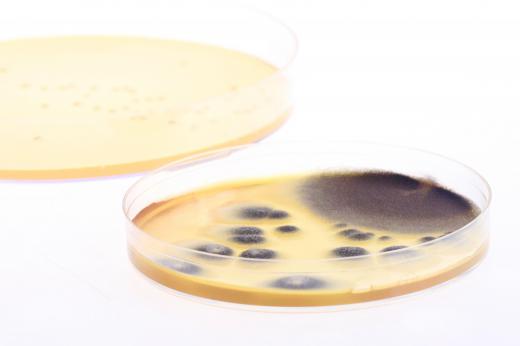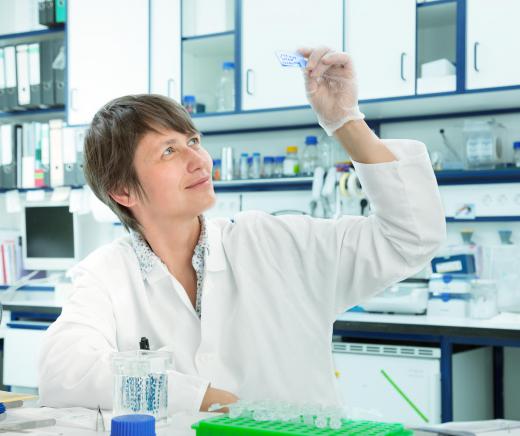What Is a Bacterial Culture?
 Mary McMahon
Mary McMahon
A bacterial culture is a cultivated colony of bacteria grown in a lab for a variety of purposes, ranging from patient diagnosis to scientific research. Cultures can take hours or days to grow and may require special care, as some bacteria are very finicky about their environment. Lab technicians typically follow a specific set of procedures to standardize the culturing process and increase the chances of success.
Successful cultures require a good sample. Doctors can use swabs to collect specimens from the site of an infection, or they can submit blood, urine, and other fluids for culture. In the case of environmental research, samples of soil, infected tissue from plants, and water can be useful for a bacterial culture. The sample must be stored in optimal conditions to ensure survival of the bacteria until they reach the lab.

There are several ways to set up a bacterial culture. One of the most common is the petri dish. The technician will prepare a shallow dish filled with gel, usually made from agar, a component of seaweed. The gel contains nutrients to support the bacteria after they are introduced. Another option is a nutrient broth, where the bacteria will be suspended in liquid. In both cases, the bacterial culture goes into an incubator to promote growth, and the technician will periodically inspect it.

As bacteria start to grow, they can cause visible changes in the culture medium. Streaks and dots may appear, and the colony can turn a variety of colors as it spreads. The technician can use a microscope to examine the bacteria and learn more about them with testing like gram staining. Technicians can also add antibiotics to the culture to test antibiotic sensitivity. If the bacteria die off, it means the drugs are working, and if the bacteria keep growing, it means they are resistant to that particular medication.

Doctors can order a bacterial culture if they believe a patient has an infection and they want to confirm the presence of disease and determine the most appropriate medication to treat it. Researchers grow bacteria to identify useful compounds, learn more about their role in the environment, and extract bacterial toxins for research. Labs must observe careful bacterial culture protocols to limit contamination, infection, and other concerns. Most are subject to inspection by regulatory officials who will make sure appropriate safety measures are being exercised.
AS FEATURED ON:
AS FEATURED ON:

















Discussion Comments
@SeamLouis-- Yes, temperature and other factors may need to be adjusted. It really depends on the bacteria and their needs. Some bacteria are easy to grow while others need a very specific type of environment. Bacterial cultures, the plate, what it contains and temperatures vary depending on the bacteria and needs.
For example, one type of agar plate culture involves the use of blood as well as heat. Here, the bacteria gain receive nutrients from the agar concentrate. The blood is there so that the technician can observe how the bacteria break down red blood cells. This is used for diagnostic purposes, as well as to determine the right treatment.
Do bacteria need anything else aside from nutrients to survive and grow? I mean, do technicians need to stabilize temperature or control air flow, etc?
My doctor did a swab test and sent it to the lab for a culture last week. The test came back positive for strep and now I'm on antibiotics. I think it's really cool how bacteria can be maintained and tested in the lab. Without the culture and diagnosis, I could have been very ill right now.
Post your comments